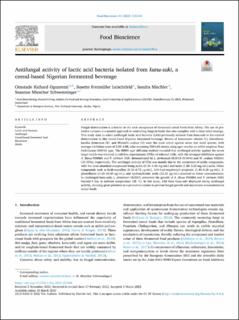Please use this identifier to cite or link to this item:
https://doi.org/10.21256/zhaw-24750Full metadata record
| DC Field | Value | Language |
|---|---|---|
| dc.contributor.author | Ogunremi, Omotade Richard | - |
| dc.contributor.author | Freimüller Leischtfeld, Susette | - |
| dc.contributor.author | Mischler, Sandra | - |
| dc.contributor.author | Miescher Schwenninger, Susanne | - |
| dc.date.accessioned | 2022-03-31T09:42:32Z | - |
| dc.date.available | 2022-03-31T09:42:32Z | - |
| dc.date.issued | 2022 | - |
| dc.identifier.issn | 2212-4292 | de_CH |
| dc.identifier.issn | 2212-4306 | de_CH |
| dc.identifier.uri | https://digitalcollection.zhaw.ch/handle/11475/24750 | - |
| dc.description.abstract | Fungal deterioration is a barrier to the wide acceptance of fermented cereal foods from Africa. The use of protective cultures is a natural approach to controlling fungi in foods that also complies with a clean label strategy. This study aims to select antifungal lactic acid bacteria (LAB) previously isolated from kunu-zaki to bio-control deterioration in this cereal-based Nigerian fermented beverage. Strains of Leuconostoc citreum (1), Limosilactobacillus fermentum (6), and Weissella confusa (3) were the most active against seven test mold species, with average inhibition score of 2.25–2.88, after screening 220 LAB strains using agar overlay on millet-sorghum flour hydrolysate (MSFH) agar. The MSFH agar diffusion method revealed that antifungal activity against the seven target molds was retained in cell-free supernatants (CFSs) of selected LABs, with the strongest inhibition against A. flavus F008BA and P. citrinum 3AS1 demonstrated by L. fermentum 5KJEU5 (9.06%) and W. confusa YKDIA1 (24.55%), respectively. The antifungal activity of CFSs was mainly due to the occurrence of acidic compounds, with the most abundant compounds being acetic (0.30–1.96 mg/mL) and lactic (1.80–3.23 mg/mL) acids. Other compounds such as hydroxycaffeic (0.16–6.72 μg/mL), 3-(4-hydroxyphenyl) propionic (1.40–6.36 μg/mL), 3-phenyllactic (1.28–24.48 μg/mL), and hydroxyferulic acids (12.25 μg/mL) occurred at lower concentrations. In challenged kunu-zaki, L. fermentum 5KJEU5 prevented the growth of A. flavus F008BA and P. citrinum 3AS1 beyond eight days at ambient temperature (25 °C). In this study, LAB from kunu-zaki displayed strong antifungal activity, showing great potential as a protective culture to prevent fungal growth and mycotoxin accumulation in cereal foods. | de_CH |
| dc.language.iso | en | de_CH |
| dc.publisher | Elsevier | de_CH |
| dc.relation.ispartof | Food Bioscience | de_CH |
| dc.rights | https://creativecommons.org/licenses/by/4.0/ | de_CH |
| dc.subject | Lactic acid bacteria | de_CH |
| dc.subject | Antifungal | de_CH |
| dc.subject | Cereal-based fermented food | de_CH |
| dc.subject | Biocontrol | de_CH |
| dc.subject | Mold | de_CH |
| dc.subject.ddc | 664: Lebensmitteltechnologie | de_CH |
| dc.title | Antifungal activity of lactic acid bacteria isolated from kunu-zaki, a cereal-based Nigerian fermented beverage | de_CH |
| dc.type | Beitrag in wissenschaftlicher Zeitschrift | de_CH |
| dcterms.type | Text | de_CH |
| zhaw.departement | Life Sciences und Facility Management | de_CH |
| zhaw.organisationalunit | Institut für Lebensmittel- und Getränkeinnovation (ILGI) | de_CH |
| dc.identifier.doi | 10.1016/j.fbio.2022.101648 | de_CH |
| dc.identifier.doi | 10.21256/zhaw-24750 | - |
| zhaw.funding.eu | No | de_CH |
| zhaw.issue | 101648 | de_CH |
| zhaw.originated.zhaw | Yes | de_CH |
| zhaw.publication.status | publishedVersion | de_CH |
| zhaw.volume | 49 | de_CH |
| zhaw.publication.review | Peer review (Publikation) | de_CH |
| zhaw.webfeed | LM-Biotechnologie | de_CH |
| zhaw.author.additional | No | de_CH |
| zhaw.display.portrait | Yes | de_CH |
| Appears in collections: | Publikationen Life Sciences und Facility Management | |
Files in This Item:
| File | Description | Size | Format | |
|---|---|---|---|---|
| 2022_Ogunremi-etal_Antifungal-activity-kunu-zaki.pdf | 3.15 MB | Adobe PDF |  View/Open |
Show simple item record
Ogunremi, O. R., Freimüller Leischtfeld, S., Mischler, S., & Miescher Schwenninger, S. (2022). Antifungal activity of lactic acid bacteria isolated from kunu-zaki, a cereal-based Nigerian fermented beverage. Food Bioscience, 49(101648). https://doi.org/10.1016/j.fbio.2022.101648
Ogunremi, O.R. et al. (2022) ‘Antifungal activity of lactic acid bacteria isolated from kunu-zaki, a cereal-based Nigerian fermented beverage’, Food Bioscience, 49(101648). Available at: https://doi.org/10.1016/j.fbio.2022.101648.
O. R. Ogunremi, S. Freimüller Leischtfeld, S. Mischler, and S. Miescher Schwenninger, “Antifungal activity of lactic acid bacteria isolated from kunu-zaki, a cereal-based Nigerian fermented beverage,” Food Bioscience, vol. 49, no. 101648, 2022, doi: 10.1016/j.fbio.2022.101648.
OGUNREMI, Omotade Richard, Susette FREIMÜLLER LEISCHTFELD, Sandra MISCHLER und Susanne MIESCHER SCHWENNINGER, 2022. Antifungal activity of lactic acid bacteria isolated from kunu-zaki, a cereal-based Nigerian fermented beverage. Food Bioscience. 2022. Bd. 49, Nr. 101648. DOI 10.1016/j.fbio.2022.101648
Ogunremi, Omotade Richard, Susette Freimüller Leischtfeld, Sandra Mischler, and Susanne Miescher Schwenninger. 2022. “Antifungal Activity of Lactic Acid Bacteria Isolated from Kunu-Zaki, a Cereal-Based Nigerian Fermented Beverage.” Food Bioscience 49 (101648). https://doi.org/10.1016/j.fbio.2022.101648.
Ogunremi, Omotade Richard, et al. “Antifungal Activity of Lactic Acid Bacteria Isolated from Kunu-Zaki, a Cereal-Based Nigerian Fermented Beverage.” Food Bioscience, vol. 49, no. 101648, 2022, https://doi.org/10.1016/j.fbio.2022.101648.
Items in DSpace are protected by copyright, with all rights reserved, unless otherwise indicated.